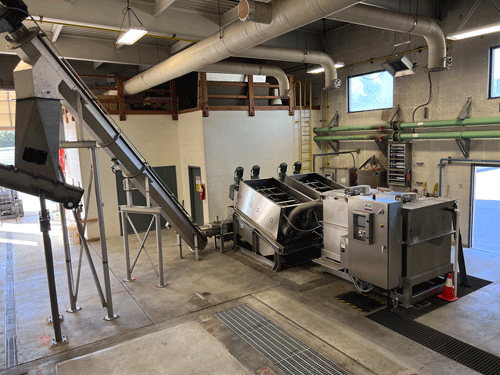
The Mammoth Community Water District (MCWD) provides water and wastewater treatment services to the community of Mammoth Lakes, California. The district manages an infrastructure consisting of 80 miles of water lines, 75 miles of sewer lines, three water treatment plants and one wastewater treatment plant. Constructed in 1965 and upgraded over the years, the wastewater plant has a design capacity of 5.48 millions of gallons per day (mgd). The district also maintains a 1-megawatt solar array to provide clean energy for the plant.1
The Challenge
Like many wastewater treatment operations across the country, MCWD was facing major changes for sludge disposal. The local landfill on which it relied for disposal was scheduled to close in early 2023. With no nearby alternatives, the closest available landfill was nearly three hours away, increasing hauling costs.
In addition, tightening environmental regulations—including mandated diversion of biosolid waste from landfills—further complicated the sludge disposal challenge. Anticipating these changes, in 2019,
MCWD developed a comprehensive Biosolids Master Plan aimed at meeting these challenges.
A key aspect of the plan involved researching the possibility of turning biosolids from a waste product into a resource like fertilizer or soil amendment. The district is researching the future possibility of disposing at a biomass facility that would need its sludge to keep it operating.
However they are disposed of, biosolids must be transported at a cost based on weight. This made reducing the weight and volume of biosolids through dewatering a key priority. The plant’s existing belt press was nearing the end of its useful life, requiring replacement or a major overhaul.
The Solution
MCWD staff evaluated several dewatering alternatives, including belt press, centrifuge and volute press technologies, and opted for a volute press technology.
Traditional volute presses have a casing with openings to allow the release of water from the sludge. If the openings are too large, the sludge will extrude through the openings and escape the press, rendering its operation useless. Most presses are designed with finer openings to retain the solids, although this allows the solids being dewatered to clog the smaller openings. To combat the clogging issue, many presses incorporate cleaning mechanisms that lead to maintenance and washwater-use issues, and require the press to be overdesigned and larger to compensate for the fact that at any point in time, most of the open area for releasing water from the sludge is clogged.
The design of the press chosen by MCWD does not have such an opening; rather, it has a dewatering drum with spacers and rings held in place with tie rods. Moving rings that are slightly smaller than the outer diameter of the screw are located between the fixed rings and are moved by the screw. The continuous movement of these moving rings cleans the gaps between the moving and fixed rings, preventing clogging and resulting in a more efficient and compact dewatering device.
It requires less maintenance and washwater than a typical volute press, while producing equivalent or drier cake solids than most dewatering technologies. This also allows the unit to produce cleaner filtrate with lower levels of total suspended solids (TSS).
Sludge entering the press passes through a flocculation tank, enters the dewatering drum, which includes a thickening zone, and then passes through a dewatering zone where it is pressed to produce the cake.
The system is fully automated, allowing unattended operation around the clock and minimal maintenance.
MCWD staff determined the volute press would meet its goals for minimizing water in the biosolids and producing a cake with high solids content. Other factors included the system’s compact footprint, reduced energy usage and operator-friendly design.
The Results
Since installing the press in late 2020, MCWD has seen dramatic benefits. Trips to the landfill were reduced, saving an estimated $500,000 in costs to date. In addition, the drier cake is optimized for potential beneficial uses as envisioned in the Biosolids Master Plan in future phases.
Operation of the unit has been trouble-free, with automation allowing dewatering to proceed when staff is not present. MCWD staff also report increased plant performance due to the lower hydraulic and TSS loading from the filtrate.
References
Mammoth Community Water District Year-End Report, mcwd.dst.ca.us


